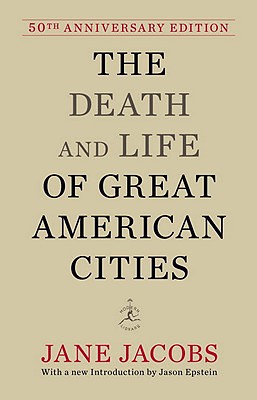 Image from "Downtown is for people," by Jane Jacobs, Fortune Magazine, April 1958.
Image from "Downtown is for people," by Jane Jacobs, Fortune Magazine, April 1958.Christopher reminds us that right around now, 50 years ago, Jane Jacobs' seminal urban studies and planning text, Death and Life of Great American Cities, was first published. The
review in the
New York Times was published 11/5/1961, and likely that was around when it came out. This is from that
review:
Mrs. Jacobs' view is that people like to live, not just be, in such lively neighborhoods. Youngsters and elders alike need such surroundings. But she scoffs at our understanding of these requirements; for we continue to put up civic centers, low density residential areas and housing "projects" segregated by income. All these developments, she complains, combine to produce boring homogeneous cores which generate traffic for limited periods and then lapse afterward into dead or dangerous districts. Worse still, the new buildings with high rents squeeze out the marginal activities, the small business man just getting a start, the colorful shop with strange and exotic waves, the little restaurants and bars, almost everything deviant, bohemian, intellectual or bizarre-- in other words, all that the author believes lends spice, charm and vigor to an area.
To brighten neighborhoods, "unslum" slums and reweave housing projects into the fabric of the city, Mrs. Jacobs proposes that we do most of the things urban experts tell us not to do: attract mixed activities which will generate active cross-use of land; cut the length of blocks; mingle buildings of varying size, type and condition; and encourage dense concentrations of people. Some of the most intriguing parts of this work involve the ingenuity with which she applies her ideas for enlivening districts such as Wall Street or Central Park after dark Greenwich Village where the author lives as her model par excellence. A few other favorite examples include the North End of Boston, Georgetown in Washington, Rittenhouse Square in Philadelphia, the "Back of the Yards" in Chicago, and Telegraph Hill in San Francisco.Leo Kottke's blog quotes from her 1958 piece, "Downtowns are for people," in
Fortune Magazine:
There are, certainly, ample reasons for redoing downtown--falling retail sales, tax bases in jeopardy, stagnant real-estate values, impossible traffic and parking conditions, failing mass transit, encirclement by slums. But with no intent to minimize these serious matters, it is more to the point to consider what makes a city center magnetic, what can inject the gaiety, the wonder, the cheerful hurly-burly that make people want to come into the city and to linger there. For magnetism is the crux of the problem. All downtown's values are its byproducts. To create in it an atmosphere of urbanity and exuberance is not a frivolous aim.

There has been a lot of reconsideration of Jacobs lately, including revisionism about Robert Moses.
I read a piece, I can't remember where, which made a good point, that maybe in part Death and Life was written at the very peak of the center city--actually the city was declining, and people knew it--but it described ideal community organization as that form of retail business, independent business, was about to shrink drastically as a result of the reorganization of various retail categories on a national scale.
I think the mistake is thinking that Death and Life solves everything. It didn't and that's too big a responsibility for one book. However, her four main precepts:
- density (or concentration) of population and activity enables a great deal of diversity of exchange;
- mixed primary uses enable a great deal of activity and efficient use/ability to share resources (such as parking) across multiple functions and dayparts;
- a network of small blocks and a street grid maximizes the opportunity for exchange and connection;
- a large stock of old buildings, with running costs low because the building is paid off, can be rented/owned cheaply, with the ability; to support innovative, new, start up, creative uses, which at their beginning stages, must minimize costs, including rent;
are key.
In the first chapter, "Jane Jacobs Revisited," of his book Cities in Full: Recognizing and Realizing the Great Potential of Urban America Steve Belmont strengthens JJ's arguments by putting numbers to the ideas, such as explaining why density matters to the success of commercial districts, neighborhoods and housing, transit, and cities and commerce more generally.
Work in urban design, such as by Jan Gehl (
Close Encounters with Buildings) and placemaking (e.g., Project for Public Spaces) also amplify the concepts in
Death and Life.
Not to mention, consideration of transportation-public transit-bicycling, which isn't addressed to a significant degree by the book, probably because in New York City, the subway service, at least in Manhattan, where she lived, is stellar.
The point is to build on and strengthen the ideas. (Two books that are good at illustrating the ideas are by Roberta Gratz, The Living City and Cities: Back from the Edge. I always say if you only have time to read one book on urbanism, Cities: Back from the Edge is the one to read--it illustrates the ideas of Death and Life through case studies and place profiles and this makes it a bit easier to grasp.
Labels: transportation planning, urban design/placemaking, urban renewal, urban revitalization, urban sociology
 Image from "Downtown is for people," by Jane Jacobs, Fortune Magazine, April 1958.
Image from "Downtown is for people," by Jane Jacobs, Fortune Magazine, April 1958.



0 Comments:
Post a Comment
<< Home